Blue calcite is one of the most powerful stones in terms of metaphysical capabilities and metaphysical uses. It has been used for centuries in the jewelry world, yet many cultures have adopted it for its benefit. Although calcites are widely available all over the world, this one is a different kettle of fish. The most common varieties come from Mexico, while the clearest ones can be found in South Africa.
While often used in jewelry for its beauty, the truth is there is a hidden benefit behind every piece. Blue calcite will not just enhance your outfit, but it will also add to the positive aura and clear negative energies. Indeed, there are people out there who use it for one reason – it is beautiful and can match various colors. But on another note, its metaphysical properties are not to be overlooked either.
This post is all about what you want ever to know pertaining to Blue Calcite. If you find it useful, don’t forget to share. Let’s get it started!
Meaning and Overview
Known in the chemical world by the CaCO3 formula, calcite is actually the most popular type of calcium carbonate in the crust of this planet. It is widely available in plenty of environments. It can be found in seashells, chalk or remains, yet specific colors tend to be more popular in certain parts of the world. All in all, calcite can be found in more forms – stalactites, nodules or fibers.
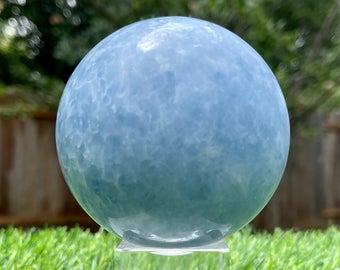
Calcite is beautiful in many forms, but more importantly, it can help you understand what double refraction means. To keep it simple, if the light hits this stone, half of it will go through, while the other half will be bent. If you put a stick of calcite into the water, it will look like it bends. Seeing an object through a thin piece of calcite will then create two distinct images.
Blue calcite is quite soft when compared to other stones. It will instantly react when in touch with mild acids. For example, a bit of vinegar on a piece of blue calcite will make it fizz. The stone will dissolve. This is the main reason wherefore it is often acid dipped when used in jewelry. This technique will preserve the integrity of the stone and add to its durability.
It is worth noting that carving, shaping or acid dipping blue calcite may affect the healing properties of the stone.
Calcite was initially referred to as a mineral in 79AD by Pliny the Elder. When burns are mixed with sand and water, it created cement. It is said that Macedonians figured it out first, but Romans then used it all across the empire, making it popular. It was also used in the form of marble by Egyptians, yet they mostly relied on yellow calcite – such as the one used for the Sphinx.
When it comes to medical and metaphysical uses, calcite was not such a common option – in fact, it has not been considered a gemstone until more modern times.
It was initially used to kill worms or maggots in wounds by Hildegard von Bingen in the 12th century. She referred to it as a good option to kill worms-eating bodies, but she has not made it too clear. It is believed she was referring to maggots, rather than intestinal worms.
Vikings used clear calcite to navigate. They referred to it as the sunstone. The stone has double refraction, which means it can help to locate the sun on a cloudy day.
Properties
Every type of calcite has its own particularities. Generally speaking, the composition is similar over various types, so many aspects are identical. But at the same time, different colors and compositions come with slight aspects that make each variety unique. Blue calcite makes no exception either. It has both physical and metaphysical properties.
Physical properties make it suitable for the jewelry industry, hence its popularity. It is not left raw, but treated for durability and looks. When used for metaphysical purposes, blue calcite is much more efficient in a raw state. Obviously, it also requires more care and maintenance.
Physical Properties
Blue calcite is generally opaque, yet you can also find clear varieties. The clear one is more common in a natural state. Shades of blue are also quite diversified. Some shades of blue are extremely pale and may look white in certain lights. You might as well find it in gray shades. On the other hand, there are also bright and lively nuances of blue that make good stones for jewelry.
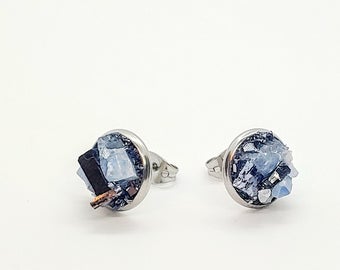
There are stones with white stripes crossing through, as well as stones with streaks in various nuances of blue, leading to a more interactive design.
Apart from blue calcite, there are other colors out there. They have different metaphysical properties, of course. After all, the color is mostly given by the minerals in its composition. All types of calcite are based on calcium carbonate though, which gets stuck to various minerals to create the shades and nuances.
When it comes to metaphysical benefits, they all depend on the minerals. Different minerals have different healing capabilities. While quite strong to touch, blue calcite is normally considered a soft stone, especially when compared to other similar stones. It looks bright and shiny – even shinier when treated for jewelry.
As for its texture, it feels like the stone has just been waxed. It feels slippery and fragile.
Metaphysical Properties
Unlike other stones, blue calcite has not been too popular in the ancient world, mostly because it was not considered to be a gemstone until more recently. However, its metaphysical properties make it a very popular choice these days.
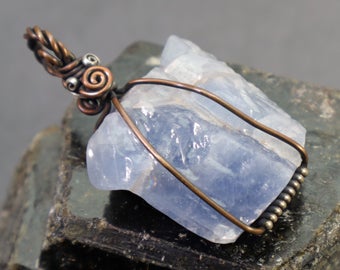
It can soothe the body, calm the nerves and relieve anxiety, depression and bad moods. Overall, blue calcite is known for providing a good mood. Practically, it clears out negative emotions and energies, but it also transforms them into positive vibes. It is a good choice for those who heal after an illness, as it boosts relaxation and calmness.
The same benefits apply to those who have suffered from an emotional issue, such as a breakup, a divorce or even the death of a family member.
Blue calcite is also efficient when used with different chakras. For instance, it can keep communication calm and clear, especially during an argument or when expressing a different point of view. When used with another chakra, it can boost intuition and instinctual decisions. There are people who meditate surrounded by blue calcite too – great to achieve a more optimistic point of view.
On a physical note, blue calcite will keep the blood pressure under control and can help against inflammation and various types of pains. It is a calming stone that will lift anxiety and soothe all nerves, so negative emotions will become history. Practically, the stone will grab all your negatives, convert this energy into positive energy and return it to you.
While often overlooked, the capacity to help people understand dreams is another big advantage of blue calcite. Not only will you be able to understand dreams and enhance their vividness, but you can also improve your dream life. If you are the type of person who can never remember dreams, it might have the answer to most of your issues.
Where to Buy Blue Calcite?
Usually Etsy or Amazon is a good idea. Etsy is the leading online global marketplace of handmade, vintage, and creative goods. Amazon is one of the largest global online marketplaces. Both of them are reliable and easy to find your favorite items there.
Blue Calcite in Jewelry Uses
Blue calcite is found all over the world. Different sources will provide different colors though. For example, you can find a plethora of varieties from Mexico, but you will also love the clarity associated with the blue calcite from South Africa. When shopping for jewelry, you will see different nuances, patterns and textures.
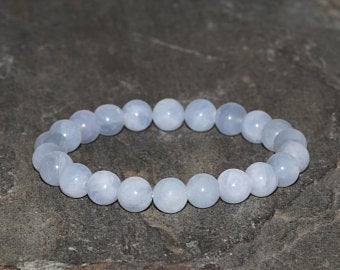
Each piece of jewelry has its own type of vibrancy. Ideally, if you want to wear a set, you should get it from the same place. If you are only looking for a necklace, a pendant or a bracelet, you can get any shade of blue that you like – ideally, something that can match your outfit or another accessory. When buying a set, blue calcite comes in a wide range of textures, nuances and designs, hence the necessity of getting all pieces from the same place.
Since it is relatively soft, blue calcite is said to be fragile. Most beads or necklaces you will find feature some sort of protection, so the metallic part holding the stone will usually be sturdy and a bit bulky. Although common in jewelry, the stone is not as popular as others. If you count the soft profile in too, it makes a good choice for carvings and ornaments. See a selection of blue calcite necklaces on Etsy.
The blue calcite hardness is similar to the hardness of amber, which is widely used in pendants and necklaces. The stone will be more durable and easier to clean in certain applications. For example, blue calcite is durable enough to be used in a pendant, a brooch or earrings. If you need it engraved, the soft profile makes it easy. See a selection of blue calcite earrings on Etsy.
It is worth noting that due to its softness, blue calcite cannot take daily wear. Such jewelry designs are still available in commerce but are not recommended. It will simply not face the test of time. It will look good, but you will need a new necklace or new earrings in no time. For this reason, it makes a better choice for special occasions.
While you can find calcite rings in commerce, they are not recommended due to the exposure of the hand and the stress such jewelry will go through. It will not last. See a selection of blue calcite rings on Etsy.
When buying blue calcite jewelry, it is important to do it by size. The carat weight is irrelevant in all colored gemstones and this stone makes no exception either. Such gemstones are quite diversified in size to weight ratio.
Caring for blue calcite jewelry can be tricky. It is very easy to get scratched, while acids can ruin it – even mild acids like vinegar. Avoid bleach too, as well as other chemicals. Steamers are just as harmful. If you need to use soap, use a mild one. Other than that, soft cloth is more than enough for wiping. Rinse the stones to get rid of the dirt and there you go.
It is highly contraindicated to keep blue calcite jewelry out before getting into physical activity, whether it comes to sports or cleaning. As for storage, keep these things separately. Keep pendants, earrings or bracelets in their own places – something soft that can keep them in place ideally. They can get scratched very easily, hence the necessity of a jewelry box with a soft lining.
Where Does Blue Calcite Come From?
Whether you are looking for a blueish gray pendant to match the electric color of your eyes or a piece of blue calcite for your meditation sessions and metaphysical properties, it is worth noting that blue calcite is widely available. It is not a precious stone, so it can be found anywhere. It is virtually available in every country out there, yet some of them can stand out in the crowd.
Madagascar is probably the main exporter of blue calcite. It represents a well-established industry there, so it is widely manufactured. Plenty of this stone comes from Mexico too – another top exporter. As for the clearest one you can find, South Africa is probably your answer.
It is important to know that blue calcite is different in every part of the world, as well as in different parts of the same country. Its unique color, patterns, textures, streaks and nuances are given by the minerals in its composition. Two different stones located miles away can be completely different – one of them can be pale grayish blue, while the other one can have a bright vibrant nuance of blue.
Where exactly does blue calcite come from? It is extracted from the Earth’s crust. It is a carbonate mineral – a common component of the crust. Such stones are available in sedimentary rocks, as well as igneous and metamorphic sediments.
Given its common profile, blue calcite is not very expensive, yet certain colors and nuances can make it look pricey if they are special.
How Much Is Blue Calcite Worth?
Blue calcite is common and available everywhere. It is not scarce, so its intrinsic value is relatively low. Given these characteristics, it is relatively inexpensive to purchase. You can find healing crystals worth a few dollars, as well as well designed jewelry that can cost hundreds of dollars. When it comes to jewelry, the metal associated with the blue calcite is what makes the difference.
Compared to other similar minerals, blue calcite is a bit more expensive because it is difficult to cut. It has perfect cleavage in three directions. In other words, if you buy a nice and smooth stone, you are not really paying for the actual stone, but for the labor involved in the cutting process. Again, it depends on what you need it for.
Due to its availability, blue calcite can also be found in large stones – up to a few pounds. They are less likely to be cut in that size though, so they will usually look raw and unfinished.
A faceted stone tends to break during the cutting process. As a result, the final gem is smaller than what the jeweler plans. In other words, cut blue calcite over 50 carats is quite rare.
How to Use Blue Calcite
Blue calcite is suitable for healers, as well as those who want a bit of peace and calmness in their lives. As a healer, you can use it at any chakra. It can be used to relieve anxiety and stress, improve mood, reduce painful sensations and clear sleep-related problems.
You do not necessarily have to be a healer to take advantage of all these benefits, as you can also use it for yourself. All in all, if used correctly, blue calcite will absorb negative energy and filter it before returning it.
The stone makes a good elixir too. It can boost the natural cleansing process of the liver, help overcome constipation and improve oxygen absorption in the respiratory system. Chest-related problems like emphysema, a low immune system and calcium deficiencies can also be handled with blue calcite.
Whether you work in an office or a facing customer role, having blue calcite next to you will improve communication and help you understand others’ points of view more efficiently. You can keep a raw stone around you or simply get some jewelry – again, there are some restrictions on what you can wear, as blue calcite can be quite fragile. For this reason, you should take it off when about to do any physical activity – just keep the stone around you.
How to Cleanse Blue Calcite?
Blue calcite is fragile and even mild acids like vinegar can ruin it. For this reason, you can only use mild soaps – if truly necessary – or just plain water. Stay away from all kinds of tools that can damage it, as it can be easily scratched. A soft cloth is ideal. You can also use a soft toothbrush – try to remove dirt buildups on jewelry with mild movements.
If the toothbrush does not work, get a small bucket, and put the stone or the piece of jewelry inside it. Pour water into it and let the stones in there for a while – up to a few hours. Take the stones out and turn them around. Are they still dirty? If yes, you can rely on pressurized water – the type of water dentists use for their wands. You can find it in commerce. You can also use a toothbrush.
What if it does not work? Perform the same operation, but add a tablespoon of baking soda for every gallon. If you have a gallon, a spoon is enough. Stir a little, then soak the stones in it. Give them half an hour to an hour. Baking soda can remove dirt. Rinse the stones, then let them dry naturally.
Compared to Other Similar Gemstones
Blue Calcite vs. Celestite
Blue calcite is often sold as celestite and the other way around. They have different properties, but they also belong to different categories. Blue calcite is part of the calcite category, while celestite belongs to the baryte group.
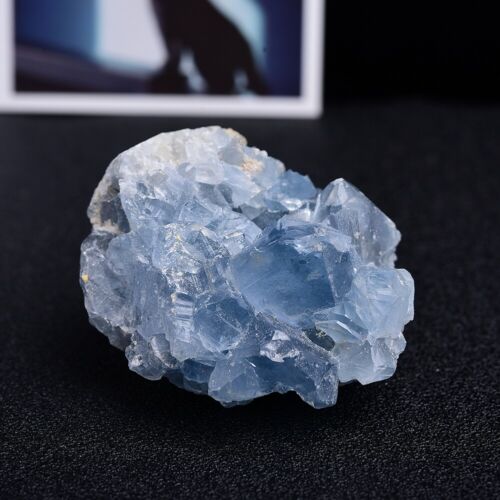
When it comes to how you can find it, celestite is almost never available in large crystals. You can find it tumbled, but it is still rare. Celestite spheres are normally geodes polished together into this shape, while blue calcite is naturally available in this form.
But then, how can you tell the difference? Apart from different streaks and stripes, you will tell the difference in weight. Grab two different pieces – one celestite and one blue calcite. They should be similar in size. Celestite will weigh about 1.45 times more than blue calcite due to its density.
You are more likely to find blue calcite sold as celestite than the other way around, as blue calcite is cheaper.
Read more: The Complete Guide to Celestite
Blue Calcite vs. Blue Quartz
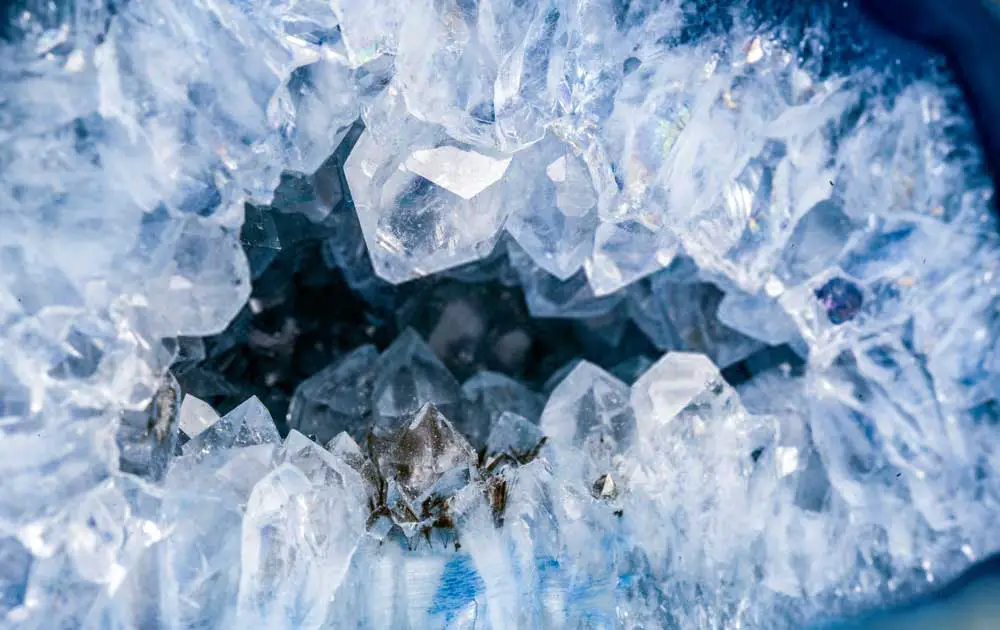
Get to know why they are different: The Complete Guide to Blue Quartz
The Best Combination to Use With Blue Calcite
Blue calcite can be used with multiple chakras, but it also works well in a tight combo with other stones. Moldavite and blue calcite work well with protective purposes and will enhance the immune system. If you feel like your third eye is blocked (the invisible eye found on the forehead), blue calcite can be mixed with phenacite.
Last, but not least, aquamarine also makes a good combination – the mix can unblock the throat chakra and allow deeper and more meaningful emotions.
Final Words
As a short final conclusion, blue calcite has a plethora of benefits in the long run. Whether you keep a stone in your bag or pocket or you wear blue calcite jewelry, you will notice the positive effects kicking in. With time, it will release your negative energy, convert it into positive energy and help you against multiple health-related problems.
Most people rely on blue calcite in the form of jewelry. It is available in brooches, pendants, rings, necklaces and other types of jewelry. It comes in sets and can provide a wide variety of textures and patterns.